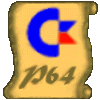Freezers
Freezing
Capturing
ISEPICking
Snapshotting
Memorydumping
Many words for the very same procedure and even though the C64 for sure was not the first machine being forced to immediately stop the currently running code and execute hackerish monitoring code instead it was a brilliant platform for it. The C64 expansion port offers all the lines which are required to force the CPU into a different memory mode, memory configs can be influenced and also DMA is available at the port. Future developments will probably show wether a whole secondary computer runs nicely in sync with a C64 but until now about anything was sooner or later becoming possible at the C64 expansion port.
Very early selfmade cartridges used the expansion port to allow running simple debugging and monitoring code whenever possible since kernal ROM modifications offered less space usually. These cartridges often came with ON/OFF switches and a reset switch so inspecting the memory was possible while loosing a little at the beginning of the C64 RAM due to the reset.
This situation was of course not really satisfactory so ways had to be found to dump the complete memory content and more important the status of the VIC chip, the CPU, the timers and color RAM as well to produce a theoretically perfect copy.
The first commercially sold cartridge using the freezing principles was ISEPIC quickly followed by Capture. ISEPIC is said to have been sold 20.000 times before going commercial. So there apparently was some demand but there was also a high demand for shorter loading times, basic extensions and improved printing functions.
Merging several functions and adding more features was the key to real commercial success in the end. Using one of the many cartridges about anyone was able to quickly produce a more or less good copy of a game or application but on extremely many cases this was not the main purpose being served.
Looking at the hundreds of thousands of disk images getting transferred nowadays there are not too many frozen programs to be found. It appears that in fact the freeze and edit functions have either supported and aided people on their creations or helped them understand problems on own and others code.
The remains of this text will deal with reviews and articles from magazines.












